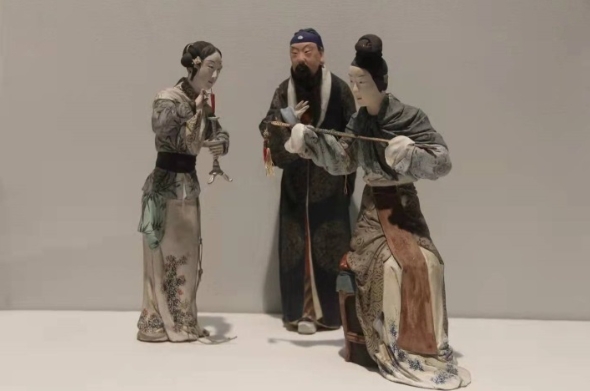
Clay Sculpture Legacy: the Century-old Tradition

the work of Zhang Mingshan
In modern Tianjin, various ideologies and artistic movements have converged, giving rise to unique cultural expressions. The clay figure, for which the Chinese name is Niren, is a famous folk art in Tianjin. One prominent figure in this field is Zhang Mingshan (张明山), known for his innovative clay sculpture style. Before him, such a style did not exist, and after him, he set the standard for future generations. His descendants continue this tradition, collectively referred to as the Niren Zhang family (泥人张).
In the Daoguang era of the Qing Dynasty (around 1821-1850 AD), Zhang Wanquan (张万全) from Shaoxing, Zhejiang province, moved his family to Tianjin, where he started a private school and made small clay toys. His son, Zhang Mingshan, was influenced by his father‘s work and began crafting clay sculptures at the age of thirteen. Gifted with keen observational skills, Zhang Mingshan broke traditional moulds, expanding the scope of clay sculpture and achieving remarkable success. By the age of eighteen, his style was already distinct, producing figures that were much larger than the previous 10-centimetre figurines, reaching heights of 30 to 40 centimetres.
His lifelike representations and vibrant colours garnered significant acclaim, making him famous not only in Tianjin but also in Beijing and beyond. The local dialect affectionately referred to him as Niren Zhang, a title given by the people of Tianjin.
Zhang Mingshan passed away in 1906, and by the time of the founding of the People's Republic of China, the Niren Zhang craft had passed through four generations. His fifth son, Zhang Yuting (张玉亭), became the second-generation heir, followed by his eldest son, Zhang Jingfu (张景福), and then Zhang Jingfu's son, Zhang Ming (张铭). Later, Zhang Ming's son, Zhang Naiying (张乃英), helped revive the family business, innovating and expanding on traditional techniques. In 1959, Tianjin established a colourful sculpture studio led by Zhang Ming, which promoted the Niren Zhang craft and trained a new generation of artists.
Today, the sixth generation is represented by Zhang Yu (张宇), who continues to refine clay sculpture while actively promoting traditional Chinese sculpture culture. Tianjin has incorporated clay sculpture into many primary and secondary schools, and universities like Nankai University and Tianjin University have introduced elective courses in clay sculpture, marking the entry of Niren Zhang's heritage into higher education.
The only brick-and-mortar store for the Niren Zhang family in mainland of China is located at No. 11 Gongbei, Ancient Culture Street Tianjin. Zhang Yu upholds the traditional boutique-style model, ensuring that each piece is crafted with meticulous attention to detail, which guarantees high quality.
In a charming art gallery tucked away in Tongqingli Hutong, visitors find a unique cultural space that harmoniously integrates the exhibition with the collector's artistic vision. The traditional courtyard layout enhances the experience, allowing viewers to appreciate the sculptures in a serene historical atmosphere. Each clay figure—whether humorous or serious—invites contemplation and connection. Every year, people of various backgrounds gather here to discuss the enduring topic of sculpture art.
As a key component of China’s rich traditional culture and intangible heritage, Niren Zhang has made a significant impact both nationally and globally, showcasing the essence and charm of Chinese culture. Since the founding of the People’s Republic of China and during the reform era, Niren Zhang has travelled an extraordinary path, achieving remarkable milestones. From the first generation's founder, Zhang Mingshan, to the current sixth-generation heir, Zhang Yu, Niren Zhang not only exemplifies the unique allure of folk art but is also poised to continue its legacy for generations to come.
Related articles
-
 Tianjin's Canal Culture: A Vital Hub of the Grand Canal System
Tianjin's Canal Culture: A Vital Hub of the Grand Canal SystemMore
-
 Echoes of Concession: The Cultural Legacy of Tianjin's Foreign Enclaves
Echoes of Concession: The Cultural Legacy of Tianjin's Foreign EnclavesMore
-
 Tianjin Song Art Troupe: the Storytelling Accompanied with Rhythmic Drums
Tianjin Song Art Troupe: the Storytelling Accompanied with Rhythmic DrumsMore
-
 Shidiao: the Opera that Brings Reputation to Tianjin as “City of Folk Arts”
Shidiao: the Opera that Brings Reputation to Tianjin as “City of Folk Arts”More
-
 Tianjin Pingshu:One of the Funniest Folk Art Forms in China
Tianjin Pingshu:One of the Funniest Folk Art Forms in ChinaMore